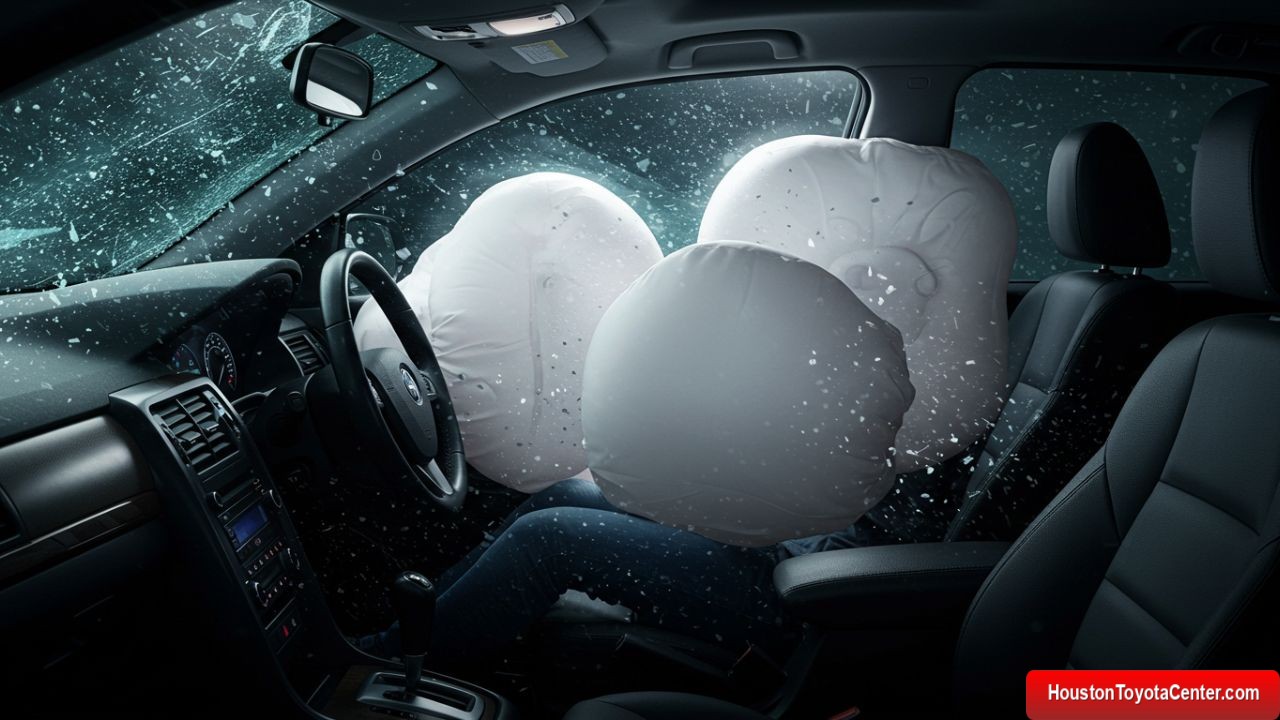Airbags are one of the most important safety innovations in modern vehicles. They have saved thousands of lives and reduced the severity of injuries in countless accidents. While we often take them for granted, airbag systems are sophisticated pieces of engineering that combine physics, chemistry, electronics, and computer algorithms to protect occupants during a crash.
In this comprehensive article, we’ll explore how airbag systems work, the different types of airbags used today, and the technology behind their deployment. You’ll also learn about new-generation airbags, maintenance tips, and what the future holds for this essential safety feature.
1. What Is an Airbag System?
An airbag system is a passive safety device designed to protect occupants during a collision by providing a cushion that absorbs impact energy. Unlike seatbelts, which restrain movement, airbags reduce the force between the occupant and hard interior surfaces, such as the steering wheel, dashboard, or side doors.
They are part of a larger Supplemental Restraint System (SRS) — meaning they work in addition to seatbelts, not as a replacement.
FREE: Quickly identify and understand problems with your vehicle 🚘
CLICK HEREAn airbag system typically includes:
- Airbag modules (with the bag and inflator)
- Crash sensors
- Control unit (ECU)
- Diagnostic and deployment circuitry
2. How Airbags Work: The Science Behind the System
When a collision occurs, milliseconds matter. Airbags must deploy, inflate, and deflate in less than one second to protect the occupants effectively.
Here’s a step-by-step breakdown of what happens when an airbag deploys:
Step 1: Crash Detection
Sensors placed around the vehicle (usually in the front bumper, doors, and undercarriage) detect sudden deceleration or impact forces that exceed a threshold.
Step 2: Signal Transmission
The sensors send signals to the Airbag Control Unit (ACU) — a specialized computer that determines if the crash is severe enough to deploy the airbags.
Step 3: Ignition of the Inflator
If deployment is necessary, the ACU triggers an electrical current that ignites a chemical propellant in the inflator.
Step 4: Inflation
The propellant rapidly produces a gas — traditionally nitrogen (N₂) — which fills the airbag within 25–50 milliseconds.
Step 5: Cushioning the Occupant
The inflated airbag provides a soft barrier between the occupant and hard surfaces. The gas inside escapes through small vent holes, allowing the bag to deflate gradually as it absorbs the impact.
Step 6: Deflation
After protecting the occupant, the airbag deflates completely within seconds, ensuring visibility and mobility for escape or rescue.
⚙️ Key Physics Concept: Energy Absorption
Airbags reduce injury by increasing the time of impact. This lowers the acceleration and, therefore, the force applied to the body.
In physics terms:
Force = Change in Momentum / Time
By extending the time over which momentum changes (from moving to stopped), the airbag lowers the overall force experienced.
3. Components of an Airbag System
Let’s examine the key components and their roles.
| Component | Function |
|---|---|
| Airbag Module | Contains the folded airbag, inflator, and housing. Installed in steering wheel, dashboard, or seat. |
| Crash Sensors | Detect rapid deceleration and send signals to the control unit. Types include accelerometers, pressure sensors, and gyroscopes. |
| Control Unit (ECU/ACU) | Analyzes sensor data, decides if deployment is required, and triggers the inflator. |
| Inflator | Contains the chemical propellant and igniter that create the gas for inflation. |
| Diagnostic System | Continuously monitors the system for faults; alerts driver via the SRS warning light. |
4. The Chemistry of Airbags
Older airbag systems relied on sodium azide (NaN₃), which produces nitrogen gas when ignited:
2 NaN₃ → 2 Na + 3 N₂ (gas)
While effective, sodium azide is toxic and has been phased out. Modern airbags now use less hazardous propellants, such as guanidine nitrate, ammonium nitrate, or tetrazole compounds.
Additionally, hybrid inflators may use stored compressed gas (like argon or helium) combined with small propellant charges for smoother inflation.
5. Types of Airbags
Modern vehicles come equipped with multiple airbags, each designed to protect specific body regions. Let’s explore the most common types:
1. Front Airbags
- Location: Steering wheel (driver) and dashboard (front passenger).
- Purpose: Protect head and chest in frontal collisions.
- Deployment Time: ~30 milliseconds after impact detection.
Front airbags are mandatory in many countries, including the U.S., since the late 1990s.
2. Side Airbags
- Location: Side of seat or door panel.
- Purpose: Protect the torso and pelvis during side impacts.
- Special Feature: Deploy horizontally between occupant and door.
3. Curtain Airbags
- Location: Roof lining above windows.
- Purpose: Protect the head during side collisions and rollovers.
- Coverage: Extend from the A-pillar to C-pillar, shielding multiple passengers.
These airbags stay inflated longer than others — sometimes up to 7 seconds — to protect during rollovers.
4. Knee Airbags
- Location: Beneath the dashboard.
- Purpose: Prevent lower-body injuries and keep the occupant in position for optimal seatbelt performance.
5. Rear Airbags
- Location: Back of front seats or in the rear doors.
- Purpose: Protect rear passengers, especially in premium and luxury vehicles.
6. Seatbelt Airbags
- Location: Built into the seatbelt strap.
- Purpose: Distribute crash forces across a wider area of the torso, reducing injury risk for children and elderly passengers.
7. Center Airbags
- Location: Between driver and front passenger seats.
- Purpose: Prevent head-to-head contact during side impacts.
Introduced in vehicles like the Toyota Yaris and Hyundai i20, this technology is becoming more common.
8. Pedestrian Airbags
- Location: Beneath the hood or windshield base.
- Purpose: Cushion pedestrians in case of collision, reducing head injuries.
9. Motorcycle Airbags
A newer innovation seen in models like the Honda Gold Wing, these deploy from the fuel tank area to protect riders in frontal collisions.
6. Advanced Airbag Technologies
The modern airbag system is far from a simple mechanical device. It’s a smart, adaptive technology that adjusts its response based on multiple variables.
Smart Sensors
Advanced sensors measure:
- Impact speed and direction
- Seat occupancy and weight
- Seat position and belt usage
- Crash angle
These inputs help determine which airbags deploy and how forcefully.
Dual-Stage Inflators
These inflators release gas in two stages — low and high pressure — depending on the severity of the collision.
- Low-pressure deployment: For minor collisions.
- High-pressure deployment: For severe crashes.
This prevents unnecessary injuries from over-inflation.
Occupant Classification Systems (OCS)
OCS uses weight sensors to detect if the passenger seat is occupied and by whom (adult, child, or empty).
If it detects a lightweight passenger, the airbag may deploy with reduced force or not at all.
Adaptive Curtain and Knee Airbags
These airbags adjust their inflation duration based on vehicle speed, occupant size, and rollover detection data.
External Airbags
Still in experimental stages, these systems aim to deploy outside the vehicle to absorb energy before the collision occurs — acting like a giant protective bubble.
7. Common Airbag Deployment Scenarios
Airbags are not designed to deploy in every crash. The system’s logic focuses on crash severity and direction.
| Collision Type | Airbags Deployed |
|---|---|
| Frontal Collision | Front, knee, and sometimes curtain airbags |
| Side Impact | Side and curtain airbags |
| Rollover | Curtain and sometimes seat-mounted airbags |
| Rear-End Collision | Usually no airbag deployment (seatbelt pretensioners may activate) |
| Low-Speed Impact (<15 mph) | Often no deployment |
8. Airbag Safety and Maintenance
While airbags are largely maintenance-free, certain precautions are important.
1. SRS Warning Light
If the airbag warning light stays on, the system has detected a malfunction. It’s essential to have it inspected immediately by a certified technician.
2. Seat Position
Maintain at least 10 inches (25 cm) between your chest and the steering wheel to allow safe deployment.
3. Child Safety
- Never place a rear-facing child seat in front of an active airbag.
- Children under 13 should always sit in the back seats.
4. Airbag Replacement
After deployment, all airbags and control modules must be replaced — they cannot be reused.
5. Recall Awareness
Always check for airbag recalls, such as the Takata airbag recall, which affected millions of vehicles worldwide due to faulty inflators.
9. The Takata Recall: A Lesson in Safety
The Takata airbag recall remains one of the largest automotive recalls in history. Faulty inflators that used ammonium nitrate could explode with excessive force, sending shrapnel into the cabin.
Over 100 million airbags were recalled globally, and automakers like Toyota, Honda, and BMW took massive steps to replace them.
This incident underscores the importance of:
- Regular maintenance
- Registering your vehicle for safety updates
- Immediate response to recall notices
10. The Future of Airbag Systems
Airbag technology continues to evolve, driven by artificial intelligence, sensor fusion, and predictive analytics.
Predictive Airbag Deployment
Next-generation systems use cameras and radar to detect an imminent crash before it happens — deploying airbags milliseconds earlier.
External Airbags for Pedestrians
Automakers like Volvo and Land Rover have tested airbags that deploy outside the vehicle to cushion pedestrian impacts.
360° Protection
Future systems aim to surround the occupant in an inflatable cocoon, protecting from multiple directions simultaneously.
Integration with Autonomous Vehicles
As self-driving cars become mainstream, airbags will adapt to non-traditional seating positions (like reclined seats or rotating chairs).
11. Pros and Cons of Airbag Systems
| Advantages | Disadvantages |
|---|---|
| Significantly reduce injury severity | Can cause minor burns or abrasions |
| Save lives in high-impact crashes | Expensive replacement after deployment |
| Work automatically with sensors | Malfunctions or faulty inflators can be dangerous |
| Integrate with seatbelt systems | Require regular diagnostic checks |
| Constantly improving with new tech | Not effective if seatbelt is not worn |
12. Key Takeaways
- Airbags are crucial life-saving systems that deploy in milliseconds to cushion impact.
- They are part of the Supplemental Restraint System (SRS) and must be used alongside seatbelts.
- Modern vehicles feature multiple airbag types, from front and side to knee and curtain variants.
- Technology continues to evolve, with smart sensors, dual-stage inflators, and AI-based predictive systems.
- Regular maintenance and recall awareness ensure optimal safety performance.
Conclusion
Airbags represent the perfect fusion of physics, chemistry, and technology — all working toward a single goal: saving lives. What began as a simple inflatable cushion has evolved into a highly intelligent safety network capable of responding in milliseconds.
As automakers move toward autonomous vehicles and AI-driven safety systems, airbags will continue to evolve, becoming more predictive, adaptive, and comprehensive. The next generation of airbags won’t just react to crashes — they’ll anticipate and prevent injury before impact.
The story of the airbag is, ultimately, the story of human ingenuity and our ongoing commitment to safety on the road. 🚗💨


Leave a Reply